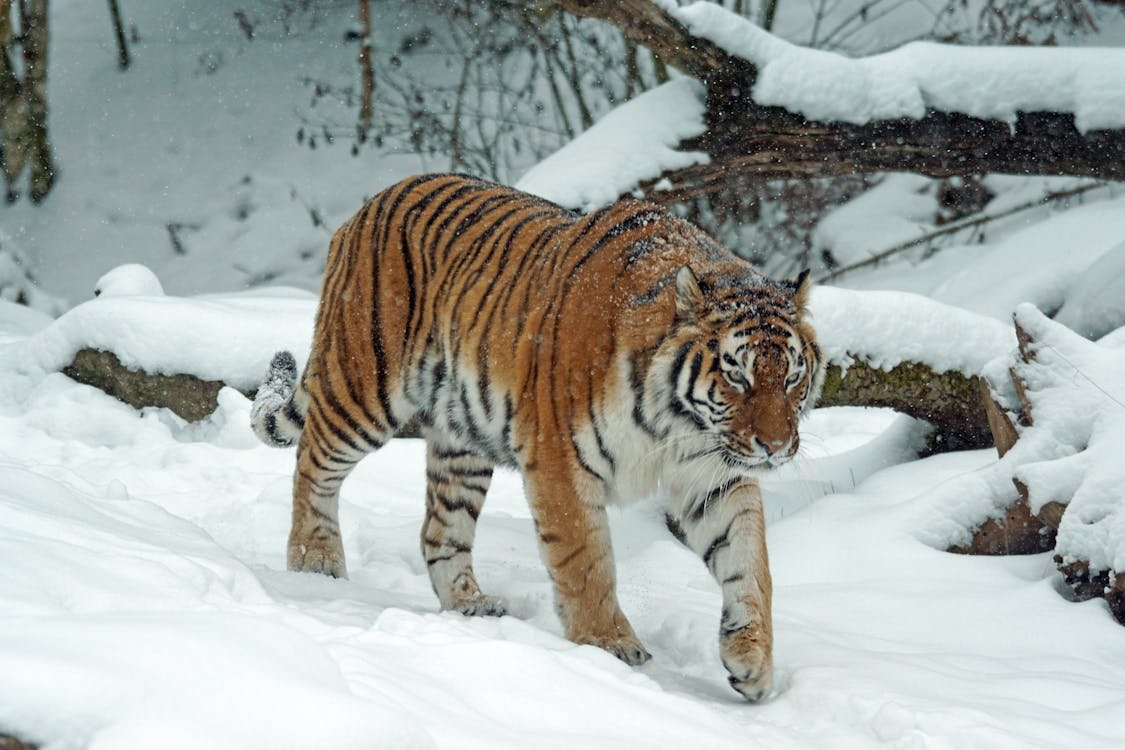The Himalayas, a majestic mountain range stretching across five countries—Bhutan, India, Nepal, China, and Pakistan—boasts one of the most diverse and unique ecosystems on Earth. This range is not only home to towering peaks like Mount Everest and K2 but also harbors an astounding variety of flora and fauna. The diverse habitats, ranging from subtropical forests at the foothills to alpine meadows and snow-capped summits, support an extraordinary array of life forms. This article explores the fascinating flora and fauna of the Himalayas, highlighting the region’s incredible biodiversity and the unique adaptations of its inhabitants.
The Himalayan Flora
The flora of the Himalayas varies dramatically with altitude, creating distinct ecological zones, each supporting unique plant communities. The diverse range of plants found in the Himalayas is a testament to the adaptability and resilience of nature.
Subtropical to Temperate Zones
At the lower altitudes (up to 1,500 meters), the subtropical forests thrive, characterized by lush greenery and a variety of tree species. Here, one can find broad-leaved trees such as sal (Shorea robusta), chir pine (Pinus roxburghii), and various species of oaks and rhododendrons. The subtropical forests gradually give way to temperate forests (1,500 to 3,000 meters), dominated by coniferous trees like deodar (Cedrus deodara), blue pine (Pinus wallichiana), and fir (Abies spp.). These forests not only provide critical habitat for wildlife but also play a crucial role in the livelihoods of local communities who rely on them for timber, fuel, and non-timber forest products.
Rhododendrons and Medicinal Plants
Rhododendrons, particularly, are iconic to the Himalayan flora. With over 30 species, these flowering plants paint the hillsides with vibrant hues of red, pink, and white during the blooming season. Among them, Rhododendron arboreum stands out with its striking red flowers, often seen as a symbol of the region’s natural beauty. In addition to their aesthetic value, rhododendrons have various uses in traditional medicine and local culinary practices.
The Himalayas are also a treasure trove of medicinal plants. The harsh climate and diverse topography have led to the evolution of plants with unique medicinal properties. For instance, the yarsagumba (Cordyceps sinensis), a rare and highly valued fungus that grows on caterpillars, is believed to have aphrodisiac and rejuvenating properties. This “Himalayan Viagra” fetches exorbitant prices in international markets, often leading to overharvesting and concerns about its sustainability. Similarly, the Himalayan blue poppy (Meconopsis betonicifolia) is not only admired for its beauty but also for its use in traditional medicine, believed to treat various ailments.
Other notable medicinal plants include the Himalayan nettle (Girardinia diversifolia), used for its fiber and medicinal properties, and the kutki (Picrorhiza kurroa), known for its liver-protective benefits. The traditional knowledge of these plants is passed down through generations, highlighting the deep connection between the local communities and their natural environment.
Alpine Meadows and High-Altitude Flora
Above the tree line, starting at around 3,500 meters, the landscape transitions to alpine meadows. These meadows, or ‘bugyals’ as they are known locally, are adorned with a stunning array of wildflowers during the short summer season. Species such as edelweiss (Leontopodium alpinum), Himalayan blue poppy, and various primulas create a colorful carpet that attracts numerous pollinators. These high-altitude meadows are not only visually captivating but also crucial for the grazing of livestock, such as yaks and sheep, which are integral to the local economy.
The highest altitudes, often above 5,000 meters, are characterized by sparse vegetation due to the extreme cold and harsh winds. However, even in these inhospitable conditions, certain plants like the dwarf willow (Salix herbacea) and cushion plants like Arenaria bryophylla manage to survive, demonstrating remarkable resilience. These plants have adapted to the extreme conditions with various strategies, such as growing close to the ground to avoid wind damage and developing thick, protective leaves to conserve moisture.
The alpine region is also home to various species of lichens and mosses, which play a critical role in soil formation and ecosystem stability. These tiny but mighty organisms are among the first to colonize bare rock, contributing to the slow but essential process of primary succession.
The Himalayan Fauna
The fauna of the Himalayas is as diverse as its flora, with many species uniquely adapted to the region’s varied climates and altitudes. From elusive predators to agile herbivores and vibrant birdlife, the Himalayan ecosystem is teeming with life.
Mammals of the Himalayas
One of the most iconic animals of the Himalayas is the snow leopard (Panthera uncia). This elusive and endangered big cat is perfectly adapted to the high-altitude environment, with its thick fur, stocky build, and long tail that helps it balance on rocky terrain. The snow leopard primarily preys on bharal (blue sheep), ibex, and other mountain ungulates. Despite its elusive nature, the snow leopard plays a crucial role in maintaining the ecological balance by controlling the population of herbivores, which in turn influences the vegetation dynamics.
Another remarkable mammal is the Himalayan tahr (Hemitragus jemlahicus), a large ungulate known for its impressive agility on steep, rocky slopes. The tahr’s thick, woolly coat and rubbery hoof pads make it well-suited for navigating the rugged terrain. The tahr is a vital prey species for predators like the snow leopard, highlighting the interconnectedness of the Himalayan food web.
Similarly, the musk deer (Moschus leucogaster) is notable for its musk gland, which has been historically prized in perfumery and traditional medicine. The musk deer is a solitary and secretive animal, often found in dense forests at high altitudes. Unfortunately, the high demand for musk has led to significant poaching, putting the species at risk.
The Himalayan brown bear (Ursus arctos isabellinus) and the red panda (Ailurus fulgens) are other significant inhabitants. The brown bear, found in the higher reaches, is one of the largest mammals in the region and primarily feeds on roots, tubers, and small mammals. The red panda, with its reddish-brown fur and bushy tail, is an arboreal mammal that primarily feeds on bamboo. It is often referred to as the “fire fox” and is a symbol of conservation efforts due to its vulnerable status. The red panda’s survival is closely linked to the health of the bamboo forests, making habitat preservation crucial.
Other noteworthy mammals include the Himalayan serow (Capricornis thar), a goat-antelope species known for its solitary nature, and the golden langur (Trachypithecus geei), an arboreal primate with striking golden fur. These species, along with many others, contribute to the rich tapestry of Himalayan wildlife.
Avian Wonders
The Himalayas are a paradise for birdwatchers, boasting over 600 species of birds. The Himalayan monal (Lophophorus impejanus), with its iridescent plumage, is the national bird of Nepal and a symbol of the region’s avian diversity. This pheasant, with its vibrant colors and elaborate courtship displays, is a sight to behold in the temperate and subalpine forests.
Other notable birds include the colorful pheasants like the cheer pheasant (Catreus wallichii) and the satyr tragopan (Tragopan satyra), known for their elaborate courtship displays. The cheer pheasant, with its distinctive call and striking appearance, is often found in open grasslands and scrublands, while the satyr tragopan inhabits dense forests and bamboo thickets.
Birds of prey, such as the lammergeier (Gypaetus barbatus) and the Himalayan griffon (Gyps himalayensis), are commonly seen soaring high above the mountains. These raptors play a crucial role in the ecosystem by scavenging and keeping the environment clean. The lammergeier, or bearded vulture, is particularly unique with its habit of dropping bones from great heights to crack them open and access the nutritious marrow inside.
The diverse habitats of the Himalayas also support various species of passerines, including the beautiful green-tailed sunbird (Aethopyga nipalensis) and the strikingly patterned fire-tailed myzornis (Myzornis pyrrhoura). These small, vibrant birds are often seen flitting among the flowers and shrubs, playing a vital role in pollination and seed dispersal.
Reptiles and Amphibians
Despite the cold climate, the Himalayas are home to a variety of reptiles and amphibians. The Himalayan pit viper (Gloydius himalayanus) is one of the few snakes adapted to high-altitude environments. This venomous snake is often found in rocky habitats and is well-camouflaged against the terrain, making it a formidable predator.
Amphibians like the Himalayan newt (Tylototriton verrucosus) and various species of frogs can be found in the region’s streams and wetlands. The Himalayan newt, with its striking black and orange coloration, is one of the few amphibians adapted to cold environments. These amphibians are essential indicators of environmental health, as they are sensitive to changes in their habitats.
Other notable reptiles include the Himalayan agama (Paralaudakia himalayana), a lizard species that thrives in rocky outcrops and basks in the sun during the warmer months. The region also hosts several species
of geckos and skinks, which are adept at navigating the rugged terrain and finding refuge in crevices and under rocks.
Invertebrates and Insects
Invertebrates, particularly insects, form a significant part of the Himalayan ecosystem. The region’s butterflies are particularly noteworthy, with species like the Bhutan glory (Bhutanitis lidderdalii) and the Kaiser-i-Hind (Teinopalpus imperialis) captivating with their vivid colors and patterns. These butterflies, along with numerous species of bees and beetles, play a vital role in pollinating the diverse Himalayan flora.
The diverse range of moths, including the giant Himalayan moth (Actias selene), adds to the region’s nocturnal beauty. These moths, with their intricate wing patterns and delicate structures, are often seen around lights at night and are important pollinators for many night-blooming plants.
The streams and rivers of the Himalayas are teeming with aquatic invertebrates, such as mayflies, stoneflies, and caddisflies. These insects are crucial for the freshwater ecosystems, serving as food for fish and other wildlife, and their presence is a good indicator of water quality.
Conservation Challenges
The rich biodiversity of the Himalayas faces numerous threats, including habitat loss, climate change, and poaching. Deforestation for agriculture and urbanization is leading to the fragmentation of habitats, which in turn affects the wildlife. The loss of forest cover not only reduces habitat for species but also disrupts the delicate balance of the ecosystem, leading to soil erosion and altered water cycles.
Climate change poses a significant threat, as rising temperatures and changing precipitation patterns alter the delicate balance of these ecosystems. The melting of glaciers and reduced snowfall impacts the availability of freshwater, which is crucial for both wildlife and human communities. Changes in temperature and precipitation also affect the distribution and behavior of species, potentially leading to mismatches in ecological relationships, such as those between pollinators and plants.
Poaching and illegal trade in wildlife, particularly of species like the snow leopard and musk deer, continue to be major challenges. The high value of wildlife products in illegal markets drives poaching, despite the significant conservation efforts in place. The trade in animal parts, such as musk, fur, and bones, poses a severe threat to the survival of many species.
Additionally, the introduction of invasive species and human-wildlife conflict further exacerbate the conservation challenges. Invasive species can outcompete native flora and fauna, leading to a loss of biodiversity. Human-wildlife conflict arises when animals such as bears and leopards come into contact with human settlements, often resulting in negative outcomes for both parties.
Conservation efforts are crucial to protect these species and their habitats. Various national parks and protected areas, such as the Sagarmatha National Park in Nepal and the Great Himalayan National Park in India, play a vital role in conservation. These protected areas provide safe havens for wildlife and serve as important sites for ecological research and monitoring.
Community-based conservation initiatives that involve local populations in protecting their natural heritage are proving to be effective. By integrating traditional knowledge and practices with modern conservation strategies, these initiatives foster a sense of stewardship and empower communities to take an active role in preserving their environment. Programs that promote sustainable livelihoods, such as ecotourism and organic farming, help to reduce the dependence on natural resources and provide alternative income sources.
Ecotourism and Sustainable Development
Ecotourism offers a sustainable way to appreciate and preserve the natural beauty of the Himalayas. Responsible tourism practices can provide economic benefits to local communities while ensuring minimal impact on the environment. Initiatives such as homestays, guided wildlife tours, and trekking expeditions not only promote conservation awareness but also contribute to the livelihood of local residents.
Efforts are being made to balance tourism with conservation. For instance, regulating the number of visitors to sensitive areas, promoting waste management practices, and educating tourists about the local flora and fauna are crucial steps. Sustainable tourism practices include the use of eco-friendly accommodations, reducing plastic waste, and supporting local handicrafts and products.
Sustainable development projects that focus on renewable energy, organic farming, and reforestation are also gaining momentum in the region. These projects not only help to mitigate the impacts of climate change but also enhance the resilience of local communities. For example, the promotion of solar energy and biogas reduces the dependence on firewood, thereby reducing deforestation and air pollution.
Reforestation and afforestation initiatives aim to restore degraded landscapes and improve biodiversity. Planting native tree species and restoring natural habitats not only benefits wildlife but also enhances the ecosystem services that support human well-being, such as water regulation and soil fertility.
The Himalayas are a treasure trove of biodiversity, home to an extraordinary array of flora and fauna. The unique adaptations of the plants and animals to the diverse and often harsh environments are a testament to the resilience of nature. However, this biodiversity is under threat, and concerted efforts are needed to ensure its preservation.
Conservation initiatives, sustainable tourism practices, and community involvement are key to protecting this natural heritage. By valuing and preserving the flora and fauna of the Himalayas, we not only safeguard the environment but also ensure that future generations can continue to marvel at the wonders of this majestic mountain range. The call to protect the Himalayas is not just a regional concern but a global responsibility, highlighting the interconnectedness of our planet’s ecosystems and the need for collective action in conservation.
Through awareness, education, and sustainable practices, we can create a future where the Himalayan flora and fauna continue to thrive. By working together, we can ensure that the beauty and biodiversity of the Himalayas remain intact, providing inspiration and sustenance for generations to come.





